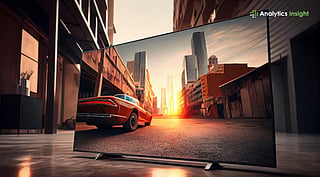
Performance and budget go hand in hand as 2025 offers excellent smart TVs for every price range, so you can get quality without overspending.
Features like QD-OLED, Mini-LED, HDR10+, Dolby Vision, and HDMI 2.1 significantly improve picture quality, motion handling, and gaming experience.
Choosing the best TV depends on your needs, whether it is for movies, bright-room viewing, gaming, or casual streaming, rather than just brand or specifications.
Modern smart TVs are defined by evolving picture engines, streamlined software, and adaptive lighting performance. Whether displaying cinematic hues, optimizing gameplay dynamics, or brightening open rooms, contemporary television screens excel in several niches. Let’s take a look at some of the best smart TVs in the current market, along with their performance specifications and features.
Also Read: Best Premium TVs in 2025: Luxury Home Theatre Picks
Few televisions balance power and polish like Samsung’s S95F QD‑OLED. The model integrates advanced panels, industry‑leading color volume, and incredible contrast. The display’s HDR features also provide impressive luminance. Its matte anti‑glare layer suppresses reflections with unmatched efficiency, maintaining image integrity in both sun‑lit and dim viewing environments.
S95F combines four HDMI 2.1 ports capable of 4K 165 Hz, complete VRR coverage, and rapid response times to provide the best gaming experience. The Slim One Connect hub streamlines connections, although Dolby Vision support is missing.
S90F brings much of the S95F’s cinematic OLED experience at a budget-friendly price. The model equips vivid QD‑OLED color and perfect blacks for impactful HDR in dark rooms. Its glossy screen doesn’t suppress reflections as effectively, and SDR brightness is lower than S95F. This display is built for moderately lit rooms and is an ideal pick for those who want performance for value.
LG B4 is the best affordable OLED option in the market. The display provides deep contrast, Dolby Vision enhancement, and wide-angle consistency, producing stunning visuals. It lacks the brightness of premium-tier models but maintains cinematic quality that feels refined.
The model integrates four HDMI 2.1 ports at 4K/120 Hz, full VRR versatility, and low-latency performance, though its reflective surface performs best away from bright ambient light.
TCL’s QM7K combines mini‑LED performance, high HDR brightness, and strong visual features such as 4K/144 Hz, making sports and action games look punchy and smooth. Blooming is well‑controlled for the class, and SDR brightness cuts through glare.
The model’s viewing angles are narrow, and some haloing and corner vignetting can appear, keeping OLED ahead in dark‑room finesse.
QM6K is one of the most budget-friendly gaming displays in the market. The model combines dual HDMI 2.1 ports, refresh rates up to 144 Hz at 4K, and smooth VRR performance for perfect playthroughs. Its contrast strength and SDR brightness handle illuminated spaces effectively when kept away from direct sunlight.
QM6K provides HDR brightness and color richness for spectacular visuals. Side viewing is restricted due to VA panel characteristics, yet considering the features offered, the display is still considered one of the top gaming TVs of its generation.
Bright rooms are augmented by S95F’s matte screen and high SDR brightness; QM7K’s mini‑LED punch also holds up well with some caveats on reflections and angles.
Dark rooms/home theaters require OLEDs for perfect representation of dark sequences. S95F and S90F are the most vivid, and B4 is the value choice with Dolby Vision.
For visual satisfaction during playthroughs, S95F provides 4K/165 Hz and the best glare control. S90F utilizes a 4K/144 Hz screen. B4 combines 4K/120 Hz with Dolby Vision for high-speed gaming. QM7K and QM6K are perfect high‑refresh LED options.
For the most versatile, premium experience, Samsung S95F is the top pick. S90F and LG B4 deliver excellent OLED features at a budget-friendly price. TCL’s QM7K and QM6K are the best performance buys in mini‑LED and budget classes. Q651G is the bare‑minimum smart TV that still covers essentials for less.
Each of these models offers unique features that put them ahead of their competition. Although these displays lead the market, the final selection is solely dependent on the user. Buyers should consider their desired product’s key features and characteristics before making a purchase.
Are OLED TVs worth it in 2025?
Yes, OLED TVs remain the best for perfect blacks, wide viewing angles, and cinematic picture quality. Models like the LG B4 and Samsung S90F offer excellent value without compromising performance.
Can I use a smart TV for gaming?
Absolutely. TVs like the Samsung S95F, S90F, LG B4, and TCL QM7K/QM6K support high refresh rates, low input lag, and HDMI 2.1, making them ideal for consoles and PC gaming.
Which TV works best in a bright room?
For bright spaces, Samsung’s S95F with a matte screen and high SDR brightness is ideal. TCL’s QM7K also performs well, though reflections and viewing angles may vary.
What is the best budget smart TV in 2025?
The TCL Q651G is a great entry-level option. It provides solid 4K visuals, HDR support, and a smooth Google TV interface, all at an affordable price.
How do I choose between OLED and Mini-LED TVs?
Choose OLED for perfect blacks, cinematic quality, and wide viewing angles. Mini-LED (like TCL QM7K/QM6K) is better for bright rooms, high HDR brightness, and high-refresh-rate gaming on a budget.
